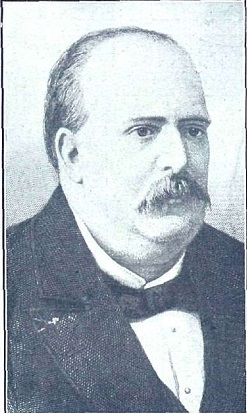Narciso Serra facts for kids
Quick facts for kids
Narciso Serra
|
|
|---|---|
 |
|
| Born |
Narciso Saénz Díez Serra
24 February 1830 |
| Died | 26 September 1877 |
| Occupation | Poet, Dramatist |
| Signature | |
 |
|
Narciso Serra (born February 24, 1830 – died September 26, 1877) was a talented Spanish poet and writer of plays. He was known for his creative works and his interesting life in Madrid, Spain.
Contents
Narciso Serra's Early Life
Narciso Saénz Díez Serra was born in Madrid, the capital city of Spain. His birth records show his parents were Alejandro Saénz Díez, a businessman, and Carlota María Petra Serra Ortega. However, many people believed his father was actually Antonio Ros de Olano, a soldier and writer.
As he grew up, Narciso Serra chose to use only his mother's surname, Serra. In Spain, people usually use both parents' surnames.
First Steps in Writing
In 1848, when he was just 18, Narciso Serra published his first comedy play. It was called "Mi mamá," which means "My Mum." The play was performed on stage that same year and was very popular with audiences. He also published a book of poems in 1848.
Military Service
When he was a young man, Narciso Serra joined the army. He eventually became an officer in the cavalry, which is the part of the army that uses horses.
Political Involvement and Health Challenges
Narciso Serra took part in the Spanish Revolution of 1854. He joined important generals like Dulce and O'Donnell. During a fight against royalist troops, he was wounded.
Later, Queen Isabella II rewarded him with a promotion in the military. The next year, he was made a "Knight of Isabella the Catholic," which was a special honor.
Leaving the Army
By 1859, Narciso Serra had reached the rank of cavalry officer. However, he asked to leave the army completely. This was because he was suffering from a condition that caused progressive paralysis. Some sources described it as a "brain ailment."
Life with Friends
Narciso Serra had many friends who were also involved in theater. These included famous writers and actors like Juan Eugenio Hartzenbusch and Julián Romea. In his younger days, he was known for having a lively and social lifestyle. He enjoyed parties and social gatherings.
Dealing with Illness
In November 1861, Narciso Serra had a serious health attack. This left the left side of his body paralyzed. A writer named Florencio Moreno Godino later wrote that Narciso was "paralyzed in his whole body, except for his head and right arm." He had to use a wheelchair. Even with these challenges, he kept writing and publishing his works.
Government Work and Legacy
After his health worsened, Narciso Serra began working for the government. In 1864, he was chosen to be a theater censor. This job involved reviewing plays before they could be performed. He resigned from this role in 1866 but was reappointed in 1867. He continued as a censor until 1868, when censorship was ended during a time of big political change called the "Glorious Revolution".
Final Years
After 1868, Narciso Serra faced financial difficulties. He passed away on September 26, 1877, in Madrid. His funeral was held on a rainy day. Many important artists and writers from Madrid attended, including José Zorrilla and José Echegaray.
Lasting Recognition
To honor his memory, the city council of Madrid named a street after him. On February 24, 1878, the "calle de Narciso Serra" was officially named in the Pacífico area of Madrid.
Narciso Serra's Works
Narciso Serra was a well-respected writer during his lifetime. Some people believe he has been unfairly forgotten since then. He worked with other writers like Miguel Pastorfido and Salvador María Granés. Between 1848 and 1854, he also performed as an actor on stage.
His plays received good reviews from other famous writers, such as Juan Valera y Alcalá-Galiano.
Some of his well-known plays include:
- "La boda de Quevedo" ("The Marriage of Quevedo")
- "Don Tomás o El loco de la guardilla" ("Don Thomas or the Crazy Guardsman")
See also
 In Spanish: Narciso Serra para niños
In Spanish: Narciso Serra para niños

